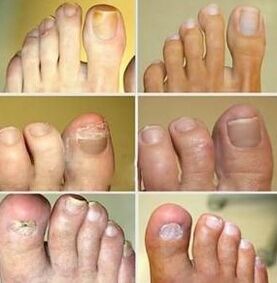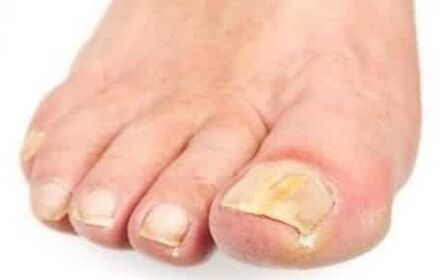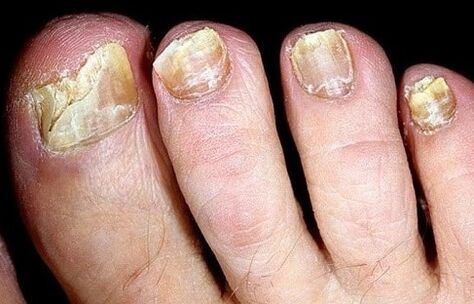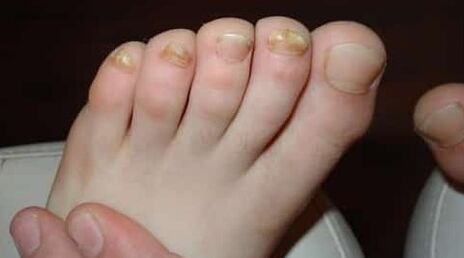Onychomycosis is a pathology that destroys nail plates.The fungus eats keratin - the nail construction base.The infection falls into the intercellular space and begins its division.In the advanced stages, pathology is capable of affecting the skin of the feet, the intercal area, the heels.

Causes of nail mushroom
An infected by onychomycosis is quite easy.Infection can be hidden on the beach, in public soul, swimming pool.A high probability of catching a mushroom of parents or infected knowledge (using common lives).
There are several main conditions that can cause the virus to enter the human body:
- A low immune system - a decrease in protection forces due to infectious or inflammatory diseases;
- Vascular pathologies (veins blocking) work violations of internal organs (diabetes), which causes blood circulation problems in the lower limbs;
- Minor damage to the skin on the feet (abrasions, microfissances, horns, horns) which occurred following the wearing of tight shoes;
- ignore the covered eruptions and the intensive perspiration of the lower limbs;
- Violation of caution measures - Try someone else's shoes, visit public places without slippers and neglect of leg hygiene.
Types of nail mushrooms
Onychomycosis can cause several types of fungi.Dermatophytes, for example, appear in the form of nail disorder.There is a formation of yellow spots along the edges or in the middle of the plate.In addition, longitudinal scratches along the affected area can be observed.
The yeast fungus causes a deformation of the nail plate.It is very sophisticated and begins to move away from its place, becomes greyish.Metabolism in wounded cells worsen, the furrows appear on the nail roller.In addition, inflammation, edema and redness appear on the adjacent epidermis, the disappearance of the nail skin is observed.
Mill bacteria can injure the nail plate if there are already diseases that cause nutritional nail disorders.In this case, there is also a disorder of the plate, a change in its color (from light yellow and greenish to brown and even black).
To discover the cause and pathogen of negative changes in the skin and nails, you must contact a specialist.An independent determination of the disease and its treatment without consulting a doctor may be responsible for consequences.
Steps of the disease

Nail mycosis gradually affects healthy cells.The disease has several stages of development, each with its own specific manifestations.
The first stage of onychomycosis (normotorophytic) has no brilliant manifestation.In most cases it is hidden.The first signs - the nail fades a little, its color changes, its microcoffres and its yellow spots are formed in the form of circles or longitudes, and the tuberosity appears.A novice fungus can be accompanied by itching and burns.It is difficult to properly recognize infection at the initial stage, as symptoms are similar to other diseases (psoriasis, hepatic pathology).
If the treatment does not start over time, the disease will pass to the next step - hypertrophic.The nail becomes thickened, dark.There is a deformation of the plate, its coronation and its destruction.
The advanced form of nail disease manifests itself by a strong slimming of the nail plate, which leads to its new rejection.The adjacent skin becomes blue, an unpleasant odor appears.
Symptoms
Onychomycosis most often affects nails on the legs, hands suffer less often.The disease begins with the thumb and the little finger (the external edge is affected), gently affecting all the plates.
The main symptoms of onychomycosis will help determine fungal infection:
- the appearance of bands and spots of a whitish or greenish shade under the nails;
- obscuring the plate, a change in its color (from yellow to dark brown);
- redness and peeling the skin around the nail;
- the appearance of roughness on the feet and between the fingers;
- The mold training on the nails.
Types of fungal nail diseases
Onychomycosis is generally classified by the appearance of affected areas.Since the classification characteristic is what the fungus looks like on the nails, it differs in three species, according to clinical manifestations:
- Atrophic, or onholytic - in which the nail plate is significantly affected, to the degree of rejection of the nail bed;
- The hypertrophic appearance, in which the one that has lost the natural brilliant, changes its color (bleached or, conversely, darkens) and the structure (more tangible) with the appearance of various types of deformations and even destroyed along the edges;
- NORMOTROPHIC - A type characterized by the lowest degree of damage, in which the nail plate does not thicken, remaining brilliant and smooth, but always transforms due to the appearance of spots, stripes and other visible changes in its natural transparency and color.

In foreign countries, there is another classification that the fungus on the nails is divided into cash depending on the specific place of the lesion:
- total, in which the whole nail plate is covered with a pathogenic process;
- Distal - the shape of damage, located only on the free edge of the nail exceeding above the finger;
- Proximal, in which the edge of the plate emerges under the nail roll is destroyed (opposite the free edge of the nail!);
- The lateral form of damage, affecting the side sides of the nail plate.
What the pathology looks like
Fungal nail diseases among the population have external similarities with other dermatological diseases of negribic nature.According to the pathology scene, the nails are starting to appear unhealthy because they lose natural radiance and transparency.Smooth and even, they become thick and deformed, and are covered with different colors (often white or dirty yellow).The soft tissues surrounding the keratin layer destroyed by a parasite are also involved in inflammatory, swollen and ulceration reactions.
If we consider the image of the destruction of the nail plate in the perspective of the dynamics of the disease, then it can be conditionally divided into three consecutive stages:
- At the very first stage, there is practically no sign, with the exception of the light dull, points or scratches on the plate.
- On the stadium pronounced SO, quickly replacing that initial, all the symptoms of onychomycosis become obvious.
- The advanced stadium is the ultimate degeneration of the nail, can be completed by the appearance of an unpleasant odor of decaying tissues.
The reasons for the deformation of the nail
Mitory, yeast -shaped fungi and dermatophytic fungi cause infectious nail diseases (onychomycosis), manifesting itself in similar symptoms.All types of nail mushrooms on the legs or arms deform the nail plate, change its transparency, its shine, its color.Changes in the nail are found not only with onychomycosis, but also for injuries, chronic paronichy (inflammation of the nail roll), psoriasis, eczem of hands, dermatitis.Before drawing a conclusion on fungal infection, you must consider all possible options.
Mushroom symptoms
There are different nail fungus classifications, depending on the type and manifestation, they may have completely different signs and symptoms, so it is very important to determine it (psoriasis, eczema, wandering lichen and dermatophyte).The superficial onychomycosis on the fingers manifests almost immediately after the infection, consider the symptoms and signs of the fungus on the nails of the legs and arms:
- Thickened plate;
- Fragile nails, friable or torn not only near the edge, but also throughout the surface;
- Distorted forms, scaly structure;
- The initial step is the loss of shine and elasticity;
- If the nail is blackened (not in the expenses in the case when a person works regularly with coloring compositions or mechanical parts);
- The nails crash under the skin;
- Dysbacteriosis begins, perhaps a general decrease in immunity, strength, drowsiness;
- Itching between the fingers and on the foot are particularly pronounced in children;
- Examination of the nail bed is a very common phenomenon and almost the last step before the complete loss of the nail, which is called onycholisis.You can feel pain in your fingers and find a slightly unpleasant odor;
- The skin becomes dry, the cracks, a rash appears, perhaps even the appearance of the blood or an unnecess;
- A white or yellow mold under the nail, depending on the variety of the fungus, it can be shiny, dull, with described edges and a muddy structure.

Before starting active actions, it is necessary to minimize the negative impact of the external environment, to eliminateThe reasons why the fungus appearedUnder the nails on the legs:
- A warm and humid environment is ideal for the growth of various microorganisms, try to dry the shoes all the time after walking, wear only natural materials that provide heat and normal air exchange;
- The foot fungus often appears due to poor immunity, you can simply walk on the ground with your naked foot and pick up the infection, take vitamins to avoid this;
- A frequent extension of the nails can become one of the causes of onychomycosis, limit the procedure up to 1 session in six months;
- The most complicated is the sympathetic - it is a fungus caused by active disputes.They enter the hollows between the nails and the fingers, can be in the sleep phase for a while, then develop suddenly.Most often, they are infected in places for public use (swimming pools, showers, solariums), when operating other people's shoes, etc.
Common types of stop mycosis
There are many ways to get an infection with a leg mushroom, but it is only possible with direct contact with the pathogen.Most often, this occurs when using other people's shoes or in violation of personal hygiene rules.The fungus of the skin on the legs generally manifests through the destruction of the dermis, which is reflected in the form of a coat.The lesions of the epidermis in this case are caused by the fact that the infection enters the deep layers of the skin, destroying its structure.
Modern medicine identifies the following options for fungal damage to the feet, each of which differs in their symptoms and treatment options:
- Intodallic mycosis is the most common form in the form of which the disease manifests.The symptom is generally located between 3 and 4 fingers, less often between 4 and 5, it looks like a crack covered with a white film.It is possible to secrete a certain amount of liquid, to take off limits, as well as the appearance of signs of gluteal erythema.Signs of interdigital fungus of the legs can be accompanied by low itching.Such a fungus on the fingers of the legs can initially occur completely without symptoms, but in the future, there is a significant change in the structure of the skin.
- The fungus of the dizzy hyperkeratic can be distinguished from other species by peeling and a severe keratinization which affect the epidermis.It is characteristic of people with various types of dermatitis, mainly atopic.This is another type of disease that can be seen clearly which fungi are on the legs.The main symptom of the disease is the appearance of erythema, a painful pink nodule, in an affected area that has clear limits.It is accompanied by weak itching, cracks on the feet, drought, pain, yellow and damage to nail plates.Onychomycosis, generally accompanying this type of fungus, leads to nail stratification;
- The vesicular fungus is one of the rarest types of infection, which affects the skin of the legs.The disease has received its name for the formation of vesiculas - bubbles with liquid content, in the place of which erosion is then formed, which is dangerous for infection.The main signs according to which fungal vesiculosis differs: the appearance of blisters with a diameter up to 1 centimeter, as well as low itching;
- Erased fungus.At the initial stage, there is a slight coat on the feet of the legs, as well as the appearance of small cracks, affecting the upper layer of the epidermis.
- The fungus is dysthidrotic, whose infection is found in medical practice only in 8% of patients infected with mycosis.It is mainly located on the sole and the safe of the foot, manifests itself in the form of bubbles, gradually merging into one, after which its gap occurs followed by the formation of extensive erosion.The danger of a fungus of this type is the possibility of connecting a bacterial infection, because pathogenic micro-organisms penetrate easily through the resulting injury;
- Intermite yeast infections occurs not only independently, but also as an accompaniment to a screaming shape of the leg mushroom.It manifests itself between the fingers of the feet, characterized by itching and serious burns, a rash and the appearance of erosion;
- Onychomycosis is another current option of damage, which is a fungus of nails on the legs.It generally develops from the free edge of the nail plate, the initial step is characterized by the appearance of yellow spots, after which the disease progresses with the relaxation and the complete driving of the nail.Often accompanies other forms of fungal lesions;
- The frank fungus, also called the erosion of yeasts, which is located in the Interdigital Space.In this case, the fungus on the legs resembles the concentration of swollen skin zones, which can be surrounded by small pustules.

















